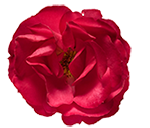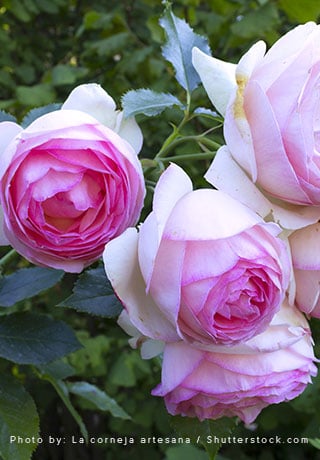HOW TO FERTILIZE ROSES
Learn how fertilizer can help you get the most out of your rosesTo perform their best, roses need a continuous source of nutrients throughout the growing season. Healthy roses not only bloom better, they are better able to withstand insect and disease problems.
There are many different kinds of fertilizers, so it can be confusing to know how and when to fertilize your roses. Here’s what you need to know to get the most out of your roses.
NUTRIENTS THAT ROSES NEED
The primary nutrients (macronutrients) that all plants need are nitrogen (N), phosphorus (P) and potassium (K).
Nitrogen encourages healthy, vigorous leaf growth. Since a rose’s ability to make flowers resides in its leaves, healthy foliage results in more flowers. Too much nitrogen will result in too much foliage and fewer blooms, while not enough nitrogen results in yellow leaves, stunted growth and smaller blooms.
Phosphorus promotes healthy root development and abundant flower production. A shortage of phosphorous can result in leaf drop, weak flower stems, and buds that won’t open.
Potassium, also referred to as potash, helps roses recover when stressed by insect and disease damage, or by extreme weather conditions. Lack of potassium can result in yellow leaf margins, weak flower stems and poorly developed buds.
Other nutrients: In order to thrive, roses also need micronutrients including calcium, magnesium, sulfur, boron, copper, iron, manganese, and zinc.
HOW AND WHEN TO FERTILIZE ROSES
FOR NEWLY PLANTED ROSES:
- Amend the planting hole with rich organic matter.
- Work in a slow-release fertilizer according to package instructions along with a handful of bone meal for healthy root development.
- Sprinkle 1/4 to 1/2 cup of Epsom salts around the base of the plant to promote foliar and cane development.
Continue to fertilize every 3 to 4 weeks with a mild fertilizer such as fish emulsion. If a new plant dries out at all, full-strength fertilizers can cause leaf margins and root tips to burn.
FOR ESTABLISHED ROSES:
Early to mid-spring: Begin fertilizing when new leaves emerge. Use a high-nitrogen fertilizer or top dress with alfalfa meal (5-1-2) for the first application to jump-start leaf development, along with epsom salts to encourage new cane development and lusher growth. Add a slow-release fertilizer when shoots are 4 to 5 inches long.
Throughout the season: Continue to feed every 2 to 4 weeks during the growing season depending on the type of fertilizer used.
Late summer to early fall: Apply a slow-release fertilizer with low nitrogen content such as bone meal to promote root growth and next year’s blooms. Stop fertilizing 6 to 8 weeks before your average first frost date to prevent new growth from being damaged by frost.
FOR CONTAINER ROSES:
Because nutrients leach out more quickly due to more frequent watering, container roses may need fertilizing more often than those planted in the ground. (See more on how to grow roses in containers.)
WHAT IS THE BEST FERTILIZER FOR ROSES?
Organic fertilizers, which are derived from plant or animal matter, are better for the environment. These have different nutritional advantages and can be used alone or in combination as part of your rose-feeding regimen. Some also improve soil texture and support beneficial microbes.
Inorganic fertilizers (synthetic, chemical, or man-made) are ready-to-use and convenient, more concentrated and often less expensive than organic. However, these products don’t improve soil and have no positive residual effect. Some also contain insecticides and should be avoided all together, as they can harm wildlife.
ORGANIC ROSE FERTILIZERS:
There are many pre-packaged organic fertilizers especially formulated for roses that take the guesswork out of fertilizing. While all have a balanced blend of nutrients, some also contain essential trace minerals and beneficial microbes. Here are a few suggestions:
- Dr. Earth Rose & Flower Fertilizer
- Espoma Rose-Tone
- Great Big Roses Organic Rose Food
- Jobe’s Organics Rose & Flower Fertilizer Spikes
OTHER ORGANIC AMENDMENTS
- Compost promotes overall plant health, helping roses to be more resilient to pests and diseases. Mix into the soil at planting time, or apply a 1- to 2-inch layer each spring around the base of established rose plants. Learn how to make your own compost at home.
- Manure can be worked into the soil at the time of planting or mulch established rose plants with a one-inch layer in spring. Make sure manure is well-aged so it doesn’t burn plants. Manure teas also work well.
- Bone meal can be applied in spring for a slow-release effect through the growing season and again in fall to promote root growth and next year’s flowers.
- Cottonseed meal boosts overall plant health. Apply once or twice a year for a slow-release effect throughout the growing season. Since it is somewhat acidic, soil pH may need to be adjusted with lime or other alkaline source.
- Kelp meal or seaweed extract promotes root development and boosts immunity to pests and diseases and can be part of a regular fertilizing program throughout the growing season.
- Fish fertilizer can be used as an all-purpose fertilizer and promotes lush growth. To use as the primary fertilizer, apply every 3 weeks during the growing season; often used in combination with kelp.
- Alfalfa is one of the best overall organic amendments, resulting in more vigorous growth and increased bloom production.
- Coffee grounds can be sprinkled around the base of rose bushes at any time during the growing season for a boost of nitrogen. Coffee is acidic, so soil pH may need to be adjusted with lime or other alkaline source. Read more about how to use coffee grounds in your garden.
- Epsom salts promote bloom color, greener foliage, and more vigorous cane growth. Apply in spring or at the time of planting.
"Organics make for the most beautiful roses and gardens," says Denise Kelly of Variegata Studios in Santa Rosa, CA. "But there can be a downside in that some products attract wildlife and pets. Bone meal and alfalfa pellets are especially attractive to dogs and raccoons, so I use alfalfa meal instead, which waters in more easily."
OVERWHELMED BY FERTILIZER CHOICES AND SCHEDULES?
If sticking to a regular fertilizer schedule seems impractical, you can still grow beautiful roses by choosing low-maintenance varieties that need little or no fertilizing. Landscape roses are a simple way to add lots of color to your garden. Unlike hybrid teas, these resilient plants don’t require extensive fertilizing or other care.
Fertilizing landscape roses is easy: simply apply a controlled release fertilizer in early spring. That’s it! No need to overwork yourself with these easy-care varieties.
The Oso Easy® series is a great choice if you don’t want to deal with remembering to keep a fertilizing schedule, or deal with pruning or constant deadheading. Plus, they’re also highly disease resistant—which means no spraying either!
ADDITIONAL TIPS:
- Soil pH affects the absorption of nutrients, and should be between 6.0-7.0. Test your soil’s pH with a soil testing meter or complete soil analysis kit to determine if it needs adjustment; then you’ll be able to choose the best amendment to regulate the pH level.
- Water roses before and after fertilizing. This will deliver nutrients more efficiently to the root zone and prevent root burn or shock.
- Avoid fertilizing in extreme heat to prevent stress. Keep rose plants well-watered and wait until it cools off to re-fertilize.
- Apply foliar sprays to roses early in the day to allow leaves to dry out to help prevent disease.
- To stay organized and on track, keep a gardening calendar handy where you can write down when and how you fertilize so that you don’t forget.
RELATED:
Pruning Roses
Rose Care: A Beginner's Guide to Growing Roses
Types of Roses







